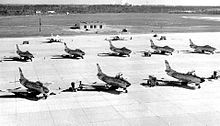Imeson Field
The hangar was built with old telephone poles and roofing made using surplus corrugated steel sheets from other city construction projects.
[1] Aviation was still considered a novelty, but he assured city leaders that air passenger service would span the nation.
[1] The city attempted to name the airport after Lucky Lindy in 1927, but San Diego, California already had Lindbergh Field.
[1][3] By 1941 the airport had expanded to 600 acres (240 ha) adding five hangars, a terminal building and five asphalt runways, the longest being 7,000 feet (2,100 m).
As part of the buildup of forces prior to the United States entry into World War II, the Army Air Corps leased Imeson Field from the City of Jacksonville on 6 February 1941.
The improved PB4Y-2 long-range maritime patrol aircraft, designed by Consolidated specifically for Navy use began to arrive during the late summer of 1944.
During 1944 and 1945 Air Service Command used Jacksonville AAF as a staging base for Station Complement squadrons prior to their overseas deployment.
With the end of the war in Europe in May 1945, the Navy antisubmarine patrol aircraft were withdrawn, and Army personnel began to be reduced at airfield.
The base was closed and declared as surplus in 1946, being was turned over to the War Assets Administration (WAA) for disposal and return to civilian use.
It was named after Thomas Cole Imeson (1880–1948), a longtime city councilman whose visionary work led to the opening of the airport in the 1920s.
[2] He later served as commissioner in charge of airports and highways and promoted improvements to its runways, hangars and terminal buildings.
The Florida Air National Guard's 159th Fighter Squadron began operations at Imeson Field on 9 February 1947 with an initial strength of 18 personnel and flying P-51 Mustangs.
With the concurrent closure of Imeson Airport and its conversion to an industrial park, the 125 FIG vacated their facilities and turned them over to the City of Jacksonville.
His transport pilot license was the first issued in Florida, and his National Aeronautics Association card was signed by Orville Wright.
A hangar at the northeast end of Imeson near North Main Street displayed Laurie Yonge's name until its demolition in the 1970s.
[1] This article incorporates public domain material from the Air Force Historical Research Agency Media related to Imeson Field at Wikimedia Commons


